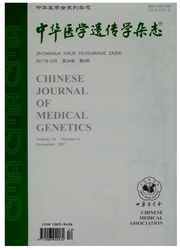

 中文摘要:
中文摘要:
目的研究SEPT7基因对人胶质瘤细胞系U251MG侵袭的抑制作用及其可能的分子机制。方法以腺病毒为载体转导SEF/7(rAd5-SEPT7)人U251人脑胶质瘤细胞系;Transwell法和3-D Matrigel法观察U251胶质瘤细胞侵袭能力的变化,划痕实验和2-DMatrigel法观察细胞迁移能力的变化。应用蛋白印记检测MMP2,MMP9,MT1-MMP,TIMP1和TIMP2的表达变化,蛋白印记和免疫荧光检测整合素α,β3的表达,以及应用激光扫描共聚焦显微镜观察细胞骨架蛋白tubulin—α结构的变化。结果转染SEF17后U251MG细胞的侵袭和迁移能力明显受到抑制、细胞MMP2、MMP9、MT1-MMP和整合素α,β3的表达下调、TIMP1和TIMP2的表达则上调;肿瘤细胞的微管蛋白tubulin—α结构出现了重新分布,发生了扭曲及聚集现象,接近于正常的非肿瘤细胞的tubulin-α结构。结论SEPT7基因可以抑制胶质瘤细胞的侵袭和迁移能力,其分子机制可能通过逆转MMPs/TIMPs的失衡状态,降低整合素α,β3的表达,以及改变细胞骨架tubulin—α的结构而实现的。SEPT7可作为基因治疗胶质瘤的重要候选基因。
 英文摘要:
英文摘要:
Objective To study the anti-invasion effect of SEPT7 gene on U251MG glioma cells and its possible molecular mechanism. Methods Recombinant adenovirus vector carrying SEPT7 gene (rAdS-SEPT7) was transduced to human glioma cell line U251MG, and empty adenovirus vector was used as control. Tumor invasion was examined by Transwell method and 3 D-Matrigel assay, and tumor cell migration by wound-healing method and 2 D-Matrigel assay. Three major molecular events associated with cell motility and migration, including changes of expression in MMP2, MMP9, MT1-MMP, TIMP1 and TIMP2, the alteration of integrin α v β3 expression, and the structural change of cytoskeleton protein, tubulin-α, in U251 cells transduced with rAdS-SEPT7 were studied by Western blotting, immunofluorescence and laser scanning confocal microscope, respectively. Results The invasive and migratory capabilities of cells transduced with rAdS-SEPT7 were inhibited. The expression of extracellular matrix metalloproteinases MMP-2, MMP-9, MT1-MMP and integrin α v β3 was significantly decreased, while the expression of matrix metalloproteinase inhibitor TIMP1, TIMP2 was upregulated. Intracellular cytoskeleton protein-tubulin-α in U251 Cells exhibited prominent morphological changes which including the appearance of distortion and aggregation resulting from redistribution of tubulin-α, and this feature of alteration was similar to the tubulin-α structure in normal non-tumor cells. Conclusion SEPT7 gene can inhibit the invasion and migration ability of U251 glioma cells. Its molecular mechanism may include that SEPT7 gene reverses the imbalanced state of MMPs/TIMPs, downregulates the expression of integrin α v β3 and alters the structure of tubulin-α of U251MG glioma cells. It is suggested that SEPT7 gene could be a good candidate for gene therapy of gliomas.
 同期刊论文项目
同期刊论文项目
 同项目期刊论文
同项目期刊论文
 期刊信息
期刊信息
